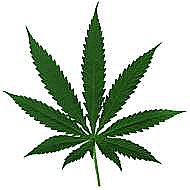
SPIDERS on marijuana are so laid back, they weave just so much of their webs and then ... well, it just doesn't seem to matter any more. On the soporific drug chloral hydrate, they drop off before they even get started.
A spider's skill at spinning its web is so obviously affected by the ups and downs of different drugs that scientists at NASA's Marshall Space Flight Center in Alabama think spiders could replace other animals in testing the toxicity of chemicals.
Different drugs have varying effects on the average arachnid addict. On benzedrine, a well-known upper, the house spider spins its web with great gusto, but apparently without much planning, leaving large holes. On caffeine it seems unable to do more than string a few threads together at random.
http://www.newscientist.com/
| Author(s): | Noever, David A.; Cronise, Raymond J.; Relwani, Rachna A. |
| Abstract: | Method of determining toxicities of chemicals involves recording and analysis of spider-web patterns. Based on observation spiders exposed to various chemicals spin webs that differ, in various ways, from normal webs. Potential alternative to toxicity testing on higher animals. |
| NASA Center: | Marshall Space Flight Center |
| Publication Date: | Apr 1, 1995 |
| Document Source: | National Technology Transfer Center (NTTC), Wheeling, WV http://ntrs.nasa.gov/ |
LSD and THC affect higher brain functions in the neocortex, an area of the brain which spiders lack.
It is highly unlikely that they would react to drugs in the same way people would.
And it is more than likely another hoax "informing us of the Dangers of Marijuana.

3 comentarios:
hola esta muy bueno tu blog... soy el webmaster de http://www.marihuanaloca.com
te interesa intercambiar enlaces conmigo?
El Blog lo tengo un poco abandonado, la verdad (donde vivo ahora lo único que se puede fumar es una cosa negruzca que huele a mezcla de pis de gato y neumático quemado, puaaajjjj), pero vale mándame el banner y te lo pongo.
Mi dirección en mi perfil.
Si quieres también te invito al Blog, te das a conocer y escribes algo.
Possession of larger amounts of marijuana is a misdemeanor punishable by up to $500 and six months is jail under Health & Safety Code 11357c. Possession of hashish or concentrated cannabis is an optional misdemeanor or felony ("wobbler") under Health & Safety Code 11357a. However, under Prop. 36 first- and second- time possession-only offenders may demand a treatment program instead of jail. Upon successful completion of the program, their conviction is erased. Possession (and personal use cultivation) offenders can also avoid conviction by making a preguilty plea under Penal Code 1000, in which case their charges are dismissed upon successful completion of a diversion program.
Marijuana defined. "Marijuana means all parts of the plant Cannabis sativa L., whether growing or not; the seeds thereof; the resin extracted from any part of the plant; and every compound, manufacture, salt, derivative, mixture, or preparation of the plant, its seeds, or its resin. It does not include the mature stalks of the plant, fiber produced from the stalks, oil or cake made from the seeds of the plant, any other compound, manufacture, salt, derivative, mixture, or preparation of the mature stalks (except the resin extracted therefrom), fiber, oil, or cake, or the steilized seed of the plant which is incapable of germination" (H&SC 11018).
Possession with intent to sell any amount of marijuana is a felony under Health and Safety Code 11359. Police often charge intent to sell if they see such indicia as: scales, cash, multiple packages, "commercial" packaging materials, "excessive" quantity, pay-owe seets, address books, pagers, etc.
Cultivation of any amount of marijuana is a felony under Health and Safety Code 11358. People who grow for personal use are eligible for diversion under Penal Code 1000 so long as there is no evidence of intent to sell. There are no fixed plant number limits to personal use cultivation..
Sale or distribution to minors is a felony under Health and Safety Code 11361.
Driving under the influence: It is unlawful to drive while under the influence of marijuana (or alcohol or any other drug) by Vehicle Code 23152. "Under the influence" is not specifically defined in the statute, but is interpreted to imply some degree of impairment. Therefore the mere fact of having taken a toke of marijuana does not necessarily mean one is DUI. For evidence of impairment, officers may administer a field sobriety test. Arrestees may also be required to submit to their choice of a urine or blood test under Vehicle Code 23612. Since marijuana is detectable for much longer periods in urine than in blood (several days vs. several hours), a positive urine test constitutes much weaker proof of recent use and impairment than a positive blood test. If you haven't smoked marijuana recently and are not under the influence, you are better off to choose a blood test, since you will probably pass it. However, if you are a chronic smoker or have smoked recently, you are better off to choose a urine test; even though you can expect to test positive, the question will at least remain open as to whether you were actually "under the influence" at time of arrest.
Forfeiture: Unlike federal law, California law requires a conviction for forfeiture of property involved in a drug crime. Also unlike federal law, state law does not permit forfeiture of personal real estate for marijuana cultivation. Vehicles may be forfeited only if 10 pounds or more of marijuana is involved. Health and Safety Code 11470
Federal Law: Marijuana is also illegal under the federal Controlled Substances Act. Federal charges are typically brought only in large cases where commercial distribution is suspected (e.g., cultivation of several hundred plants).
Publicar un comentario